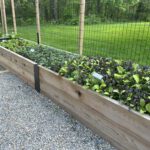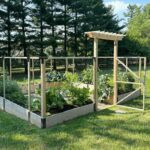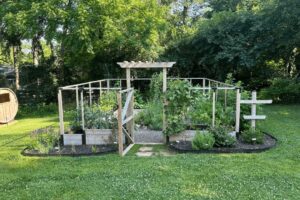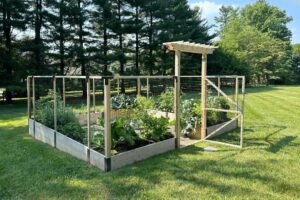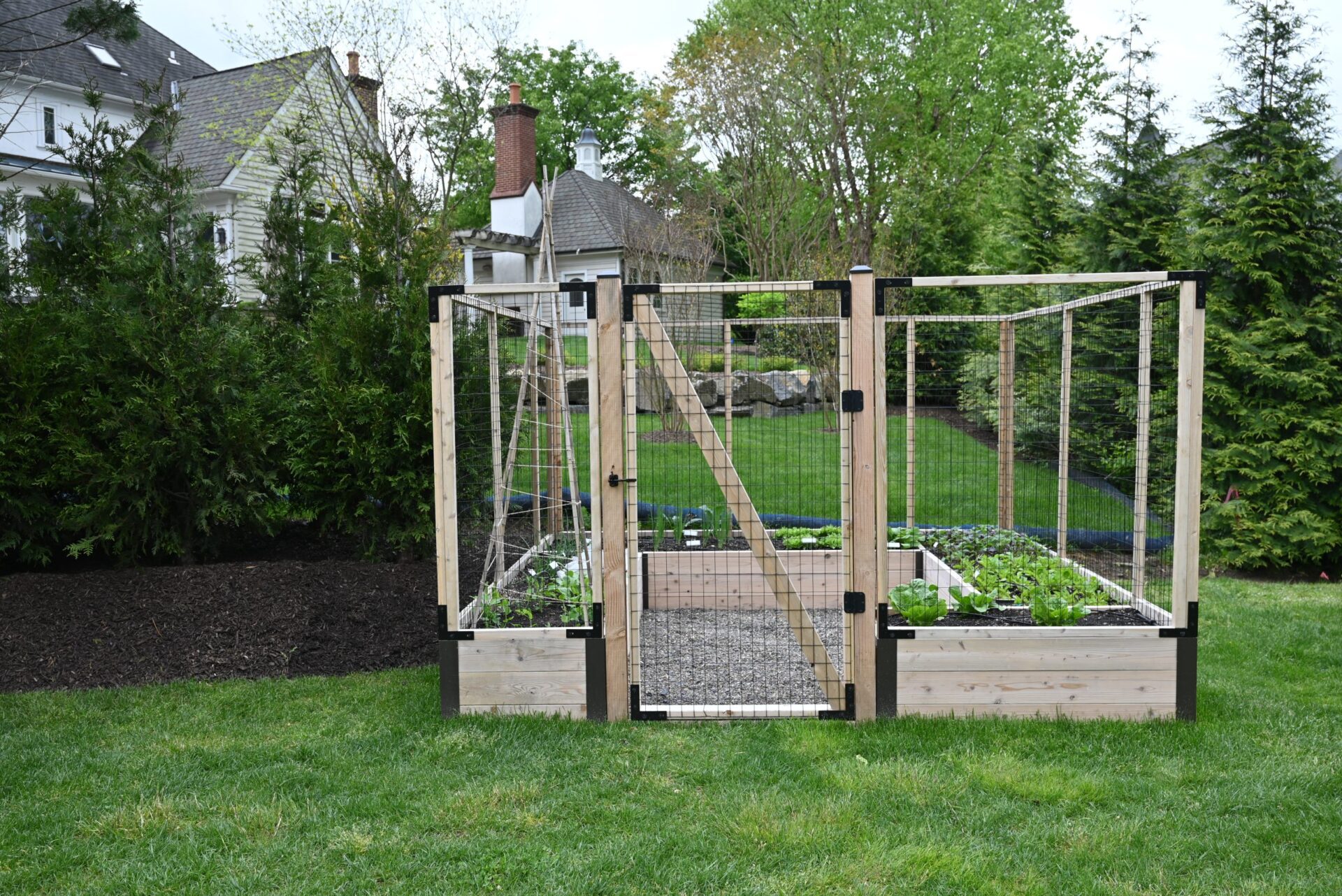
[et_pb_section fb_built=”1″ admin_label=”section” _builder_version=”4.16″ da_disable_devices=”off|off|off” global_colors_info=”{}” da_is_popup=”off” da_exit_intent=”off” da_has_close=”on” da_alt_close=”off” da_dark_close=”off” da_not_modal=”on” da_is_singular=”off” da_with_loader=”off” da_has_shadow=”on”][et_pb_row admin_label=”row” _builder_version=”4.16″ background_size=”initial” background_position=”top_left” background_repeat=”repeat” global_colors_info=”{}”][et_pb_column type=”4_4″ _builder_version=”4.16″ custom_padding=”|||” global_colors_info=”{}” custom_padding__hover=”|||”][et_pb_text _builder_version=”4.27.4″ _module_preset=”default” text_text_color=”#000000″ link_font=”|700|||on|||#000000|” link_text_color=”#000000″ header_2_line_height=”1.5em” header_2_font_size_tablet=”” header_2_font_size_phone=”23px” header_2_font_size_last_edited=”on|phone” global_colors_info=”{}”]
After selecting the perfect location for your raised bed garden, it’s time to plan your layout and decide on the size of your space. This will depend on your gardening goals, the landscape, and existing garden infrastructure. Consider how you plan to cook with your produce and whether you’ll be using vertical space, as both will influence your garden’s yield and size.
[/et_pb_text][et_pb_text _builder_version=”4.27.4″ _module_preset=”default” text_text_color=”#000000″ link_font=”|700|||on|||#000000|” link_text_color=”#000000″ header_2_line_height=”1.5em” hover_enabled=”0″ header_2_font_size_tablet=”” header_2_font_size_phone=”23px” header_2_font_size_last_edited=”on|phone” global_colors_info=”{}” sticky_enabled=”0″]
What Size Should My Garden Be?
Before finalizing the layout, determine the size of your garden footprint. This will depend on the amount and type of produce you want to grow.
Do you aim to feed your family year-round, including preserving produce for the winter? A larger garden space, optimized with irrigation and fencing, will suit your long-term needs. However, even if you dream of a large garden, ask yourself if you’re prepared to maintain it consistently. A sprawling garden can quickly become overwhelming and unmanageable if you don’t have the time to care for it. In that case, consider creating a more manageable space or hiring a gardener for assistance.
Here are some questions to help guide your decision:
- How many people will this garden feed?
- Do I want to garden as a hobby or to provide for my family?
- How much time do I have to manage the garden?
- Is a larger space necessary?
[/et_pb_text][et_pb_image src=”https://backyard-eats.com/wp-content/uploads/2023/12/Copy-of-Copy-of-DSC_7132-scaled.jpeg” alt=”Raised bed garden for annual vegetables” title_text=”Copy of Copy of DSC_7132″ show_bottom_space=”off” _builder_version=”4.27.4″ _module_preset=”default” custom_margin=”20px||20px||true|false” global_colors_info=”{}”][/et_pb_image][et_pb_text _builder_version=”4.27.4″ _module_preset=”default” text_text_color=”#000000″ link_font=”|700|||on|||#000000|” link_text_color=”#000000″ header_2_line_height=”1.5em” hover_enabled=”0″ header_2_font_size_tablet=”” header_2_font_size_phone=”23px” header_2_font_size_last_edited=”on|phone” global_colors_info=”{}” sticky_enabled=”0″]
Many new gardeners assume they need a large, expansive garden to grow a lot of food. While a big garden can be an inspiring image, you may find that it’s larger than you actually need or too difficult to maintain. With the right infrastructure, growing conditions, and soil care, even a small garden can yield a satisfying amount of produce. For example, a single tomato plant in a healthy raised bed can produce 2 to 10 times more than a hobbyist’s typical tomato plant. Instead of planting 10 or more tomato plants, you might be happier with 2 to 6 well-performing plants.
Vertical structures, like trellises, can further increase your harvest without expanding your garden’s footprint. By maximizing vertical space, you reduce the risk of fungal diseases and improve airflow, which promotes better plant health and productivity. Plus, crops like squash, which can quickly overrun a garden bed with sprawling vines, can be trained vertically, freeing up space for shorter crops like greens or herbs.
[/et_pb_text][et_pb_text _builder_version=”4.27.4″ _module_preset=”default” text_text_color=”#000000″ link_font=”|700|||on|||#000000|” link_text_color=”#000000″ header_2_line_height=”1.5em” hover_enabled=”0″ header_2_font_size_tablet=”” header_2_font_size_phone=”23px” header_2_font_size_last_edited=”on|phone” global_colors_info=”{}” sticky_enabled=”0″]
Garden Size Guidelines
If you’re a beginner, we recommend starting with around 64 square feet of growing space. This is equivalent to two 4×8 raised beds, which can typically fit in a 12×12′ area. This size allows you to experiment with a variety of crops during spring and summer.
For example, the average Backyard Eats garden spans 80-100 square feet. With more space, you’ll have room to experiment with different crop varieties or grow larger quantities of your favorite crops.
Gardens larger than 125 square feet are considered “large,” and these are often best for large families, those seeking self-sufficiency, or shared community garden spaces.
[/et_pb_text][et_pb_image src=”https://backyard-eats.com/wp-content/uploads/2024/06/AI-Garden_Darker_Compressed.webp” alt=”Photo of large school garden with fencing and a gate arbor” title_text=”AI-Garden_Darker_Compressed” show_bottom_space=”off” _builder_version=”4.27.4″ _module_preset=”default” custom_margin=”20px||20px||true|false” global_colors_info=”{}”][/et_pb_image][et_pb_text _builder_version=”4.27.4″ _module_preset=”default” text_text_color=”#000000″ link_font=”|700|||on|||#000000|” link_text_color=”#000000″ header_2_line_height=”1.5em” hover_enabled=”0″ header_2_font_size_tablet=”” header_2_font_size_phone=”23px” header_2_font_size_last_edited=”on|phone” global_colors_info=”{}” sticky_enabled=”0″]
Perennials in Raised Bed Layouts
Keep in mind that these square footage recommendations apply to raised beds with annual crops. Many perennials, like shrubs and berries, grow better outside of raised beds and are better suited for your landscape. These perennials typically don’t affect the footprint of your raised bed garden unless you plan to add perimeter planting beds around them.
Some perennials, such as strawberries and asparagus, can be planted in raised beds. However, we recommend keeping strawberries in separate beds from annual crops because they tend to spread and take over. For strawberries or asparagus, aim for at least 20 square feet of space, though 32+ square feet is ideal.
[/et_pb_text][et_pb_text _builder_version=”4.27.4″ _module_preset=”default” text_text_color=”#000000″ link_font=”|700|||on|||#000000|” link_text_color=”#000000″ header_2_line_height=”1.5em” header_2_font_size_tablet=”” header_2_font_size_phone=”23px” header_2_font_size_last_edited=”on|phone” global_colors_info=”{}”]
Conclusion
By thoughtfully planning your garden’s size and layout, you can create a space that suits your needs and goals, whether you’re growing food for your family or enjoying gardening as a hobby. Focus on what will work for you and remember that a smaller, well-maintained garden can produce a rewarding harvest.
Book a consultation today to learn how we can help design, build, and maintain your dream edible garden!
[/et_pb_text][et_pb_button button_url=”@ET-DC@eyJkeW5hbWljIjp0cnVlLCJjb250ZW50IjoicG9zdF9saW5rX3VybF9wYWdlIiwic2V0dGluZ3MiOnsicG9zdF9pZCI6IjU4MjY0In19@” url_new_window=”on” button_text=”BOOK A CONSULTATION” button_alignment=”left” button_alignment_tablet=”left” button_alignment_phone=”left” button_alignment_last_edited=”on|tablet” disabled_on=”off|off|off” _builder_version=”4.27.0″ _dynamic_attributes=”button_url” _module_preset=”737bea5a-e063-4b24-af3f-21ce28f0bf38″ button_bg_color=”gcid-3b5ac83a-684c-4379-a559-60b2aa9e8157″ button_border_color=”gcid-3b5ac83a-684c-4379-a559-60b2aa9e8157″ button_letter_spacing=”1px” button_font=”Roboto|700||on|||||” z_index=”90″ custom_margin=”0px|0px|30px|0px|false|false” custom_margin_tablet=”0px|0px|0px|0px|false|false” custom_margin_phone=”0px|0px|0px|0px|false|false” custom_margin_last_edited=”on|desktop” locked=”off” global_colors_info=”{%22gcid-3b5ac83a-684c-4379-a559-60b2aa9e8157%22:%91%22button_border_color__hover%22,%22button_bg_color%22,%22button_border_color%22%93}” button_text_color__hover_enabled=”on|hover” button_text_color__hover=”#844B67″ button_bg_enable_color__hover=”on” button_border_color__hover=”#88667b” button_border_color__hover_enabled=”on|desktop”][/et_pb_button][/et_pb_column][/et_pb_row][et_pb_row _builder_version=”4.27.3″ _module_preset=”default” global_colors_info=”{}”][et_pb_column type=”4_4″ _builder_version=”4.27.3″ _module_preset=”default” global_colors_info=”{}”][et_pb_cta title=”Join Our Newsletter” button_url=”https://backyard-eats.com/email-newsletter-sign-up/” button_text=”Sign Up” _builder_version=”4.27.3″ _module_preset=”default” background_color=”#88667B” global_colors_info=”{}”]
Do you want to increase your confidence and knowledge as a gardener? Join our newsletter! In our newsletter we feature seasonal gardening updates, relevant harvesting advice, garden project inspiration and more. You can unsubscribe anytime.
[/et_pb_cta][/et_pb_column][/et_pb_row][/et_pb_section]

